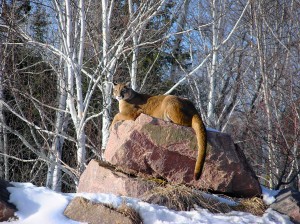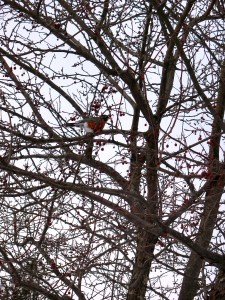“Feb 4. F. Brown showed me this afternoon his game killed day before yesterday — a gray hare, a gray squirrel and a red squirrel…The gray was a fine large fellow in good condition; weighed one pound and a quarter…and his tail still perfectly and beautifully curved over his back. It recovered its place when you stroked it, as if it were full of electricity.” Henry Thoreau, Journal, 1854
A number of years ago, when wolf-advocacy groups were first making their case for this canid’s return to our region, I went to a lecture (and showing) by Wild Sentry at the Thoreau Institute. The talk took place in a crowded central hall (there must have been around 100 people there), and it treated the audience to various arguments and facts for this topline predator’s recovery or restoration in the ungulate-heavy woods of the northeast. But most of us were already persuaded of this need, and so we were there for the star of the show, a wolf rescued and sheltered by the presenters. He would descend the central staircase after the talk; in an odd cultural inversion, it would be a “runway moment.”
For this evening, I was carrying a local press pass, and so I got a few moments behind the scenes. Outside, before the talk, I met Koani, a 100-pound, 6-year-old black wolf. By now an experienced “ambassador,” Koani still seemed a little uncertain about the hand I extended so she could sniff it. But then, after a long sniff, she raised and stretched out her right paw to ask for a pat. Long silly about dogs, I was delighted. And, as I ran my hand along Koani’s back, I was surprised – the fur beneath my palm was wiry and stiff; it was unlike any fur I’d patted before. There, in the dark, I had my hand on a wildness that had been absent from New England since the last wolf in Maine was killed in 1909. “Welcome back,” I said.
Koani
This moment came back to me while reading Thoreau’s journal and the entry excerpted in this posting. Thoreau is always reaching out with his hands, picking up this pinecone, examining that flower, and here, when presented with a squirrel’s tail “still perfectly and beautifully curved over his back,” Thoreau strokes it. And “it recovered its place…as if it were full of electricity.”
All of this reminds me what it is to be in touch with the world. Today, while I walked, it reminded me to run my hands over the rough, corrugated bark of a large white pine.
Odd Note about Touch: Once I’d written this posting, I did what I often do when I’ve referred to a group or a program – I googled them. At the top of a list of results, I found a movie, True Wolf…that Pat Tucker and Bruce Weide, the two people of what they called “their pack” – themselves, a wolf (Koani) and a dog – have made about their experiences teaching people about wolves for 16 years. Here’s the link: http://www.truewolfmovie.com/
Official Movie Poster – True Wolf




